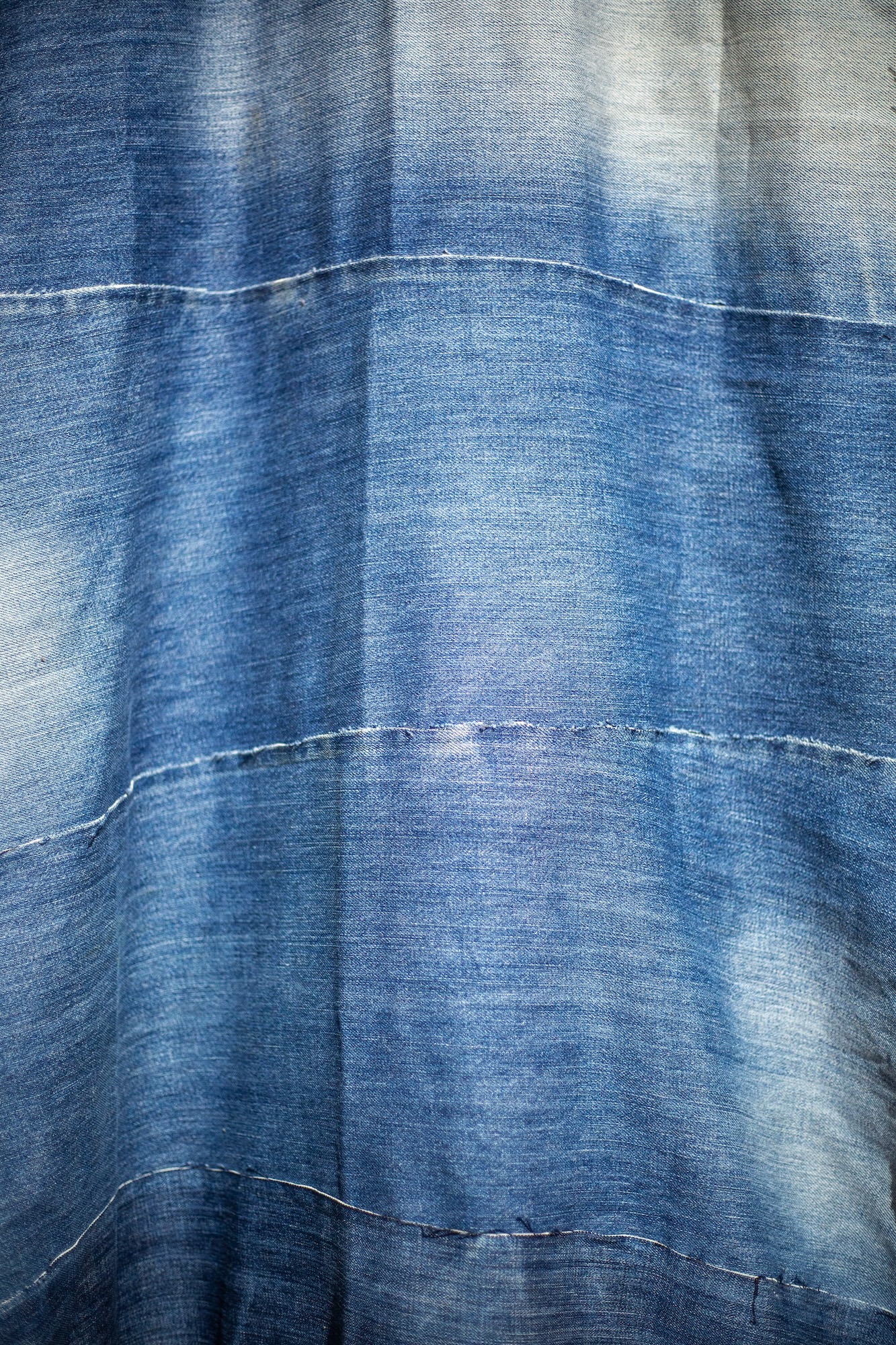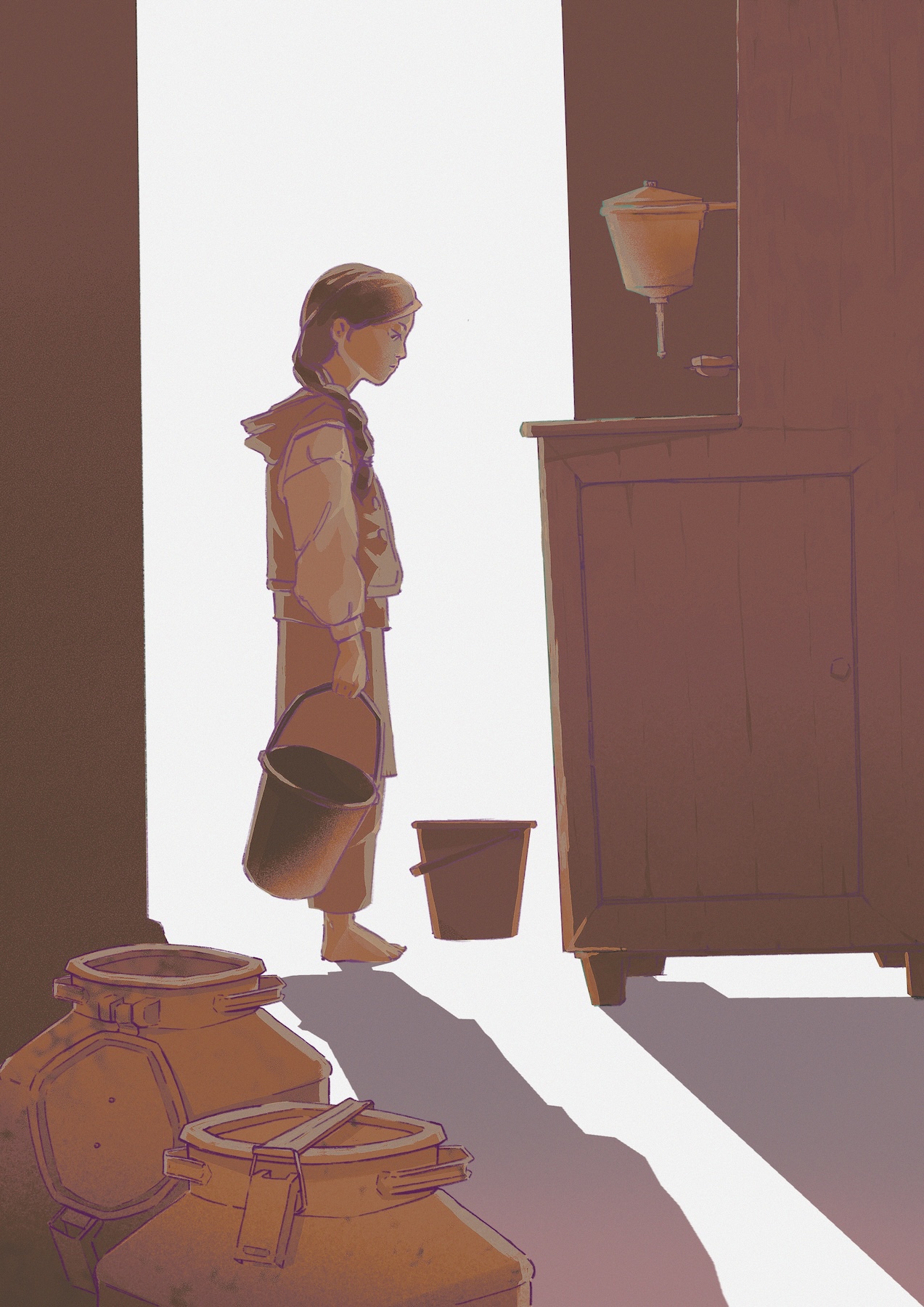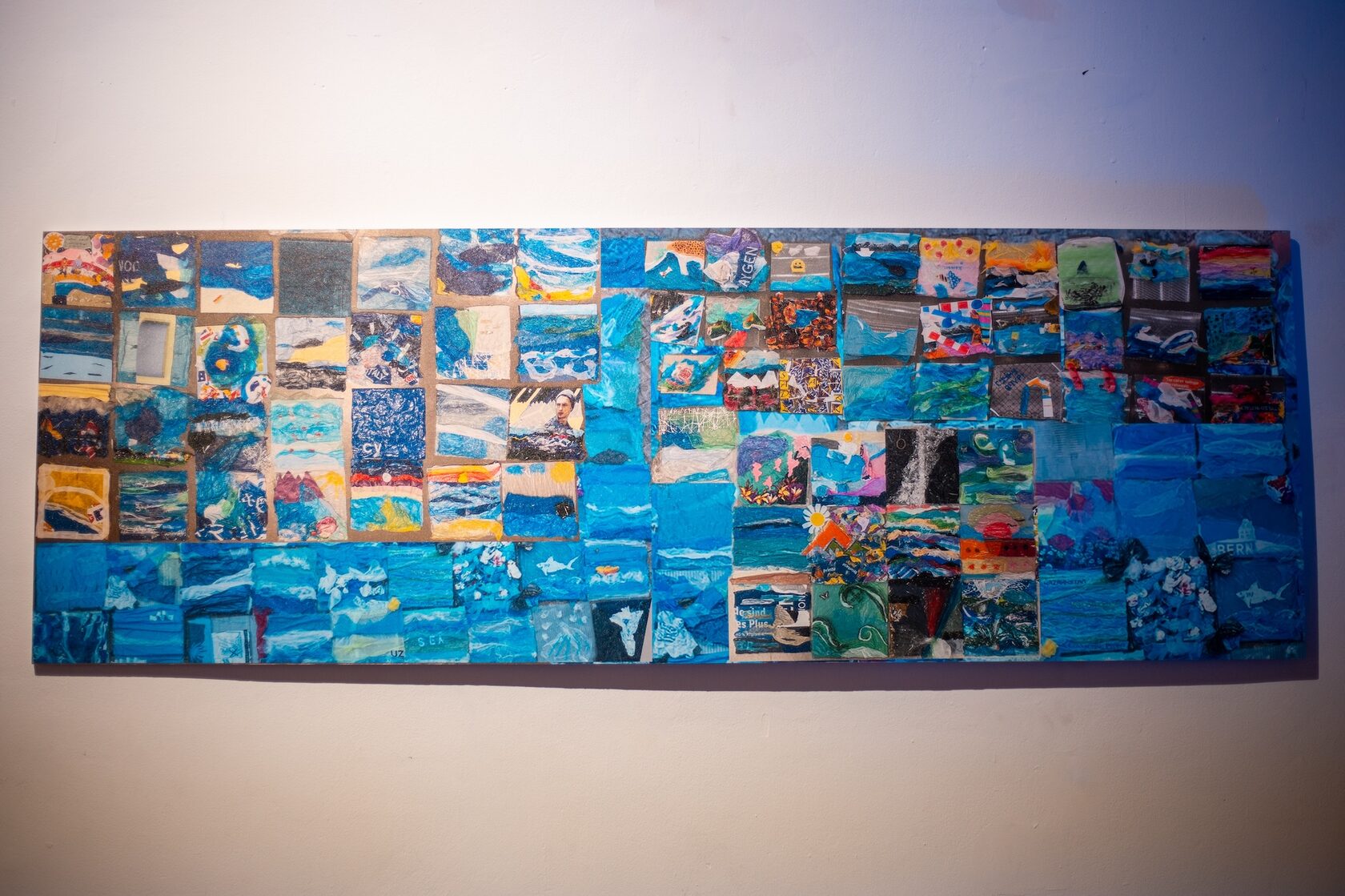The Flow of Life: Water and its Price
The female artists explored water in Central Asia, reflecting on humanity’s relationship with it, potential crises, and ways of restoration.
Artworks
From October 25 to November 10, the collective exhibition “The Flow of Life: Water and Its Price” was held at “Dom 36” in Almaty, Kazakhstan.
Fairytale
Intizor Otaniyozova in collaboration with Anastassia Konovalova
Previously, irrigation ditches ran through the entire city, the water in them bubbled and ran without obstacles. People actively used them: they washed their clothes in them, washed their feet, etc. Previously, people could say that mermaids lived in the ditches, a little later that apples that fell from trees floated in them, and now we only notice garbage in them. Now we fall into them, they flood us during heavy rains, and as much as we would like to be nostalgic about the ditches, it is worth admitting that we need more modern rain and irrigation systems. Perhaps soon we will tell each other about ditches only in fairy tales.
Special thanks to Zhaniya Sakenbaeva for technical support.
Previously, irrigation ditches ran through the entire city, the water in them bubbled and ran without obstacles. People actively used them: they washed their clothes in them, washed their feet, etc. Previously, people could say that mermaids lived in the ditches, a little later that apples that fell from trees floated in them, and now we only notice garbage in them. Now we fall into them, they flood us during heavy rains, and as much as we would like to be nostalgic about the ditches, it is worth admitting that we need more modern rain and irrigation systems. Perhaps soon we will tell each other about ditches only in fairy tales.
Special thanks to Zhaniya Sakenbaeva for technical support.
Water Fabrics: From Destruction to Creation
This installation is dedicated to the water problems of Central Asia, highlighting the need for urgent attention to the preservation of the region’s water bodies. It is a series of photographs of water bodies, including both active and those on the verge of extinction, as well as completely dried up water bodies.
The photographs are printed on canvas and sewn using the traditional Kazakh patchwork technique — kurak, symbolizing both destruction and creation.
Kurak comes from the word “kuru”, which has two opposite meanings: “death” and “creation”. This expresses the duality of our reality: from destruction to rebirth, from chaos to harmony. This symbolism is reflected in the technique itself, where each piece of fabric, like each body of water, is combined into a single canvas — the embodiment of the cyclicality of life.
The water resources of Central Asia are dying before our eyes. If we do not pay attention now, the consequences will be catastrophic for the ecosystem and for future generations. This work is a call to realize that the balance between destruction and creation is in our hands.
The photographs are printed on canvas and sewn using the traditional Kazakh patchwork technique — kurak, symbolizing both destruction and creation.
Kurak comes from the word “kuru”, which has two opposite meanings: “death” and “creation”. This expresses the duality of our reality: from destruction to rebirth, from chaos to harmony. This symbolism is reflected in the technique itself, where each piece of fabric, like each body of water, is combined into a single canvas — the embodiment of the cyclicality of life.
The water resources of Central Asia are dying before our eyes. If we do not pay attention now, the consequences will be catastrophic for the ecosystem and for future generations. This work is a call to realize that the balance between destruction and creation is in our hands.
Mermaid’s Treasures
Masha Golm
“Mermaid’s Treasures” is a live installation that immerses viewers in a frightening reality, where a mythological creature has become a hostage of the modern world.
The mermaid, deprived of natural beauty, is forced to wear jewelry made from trash — plastic bottles, cans, trash collected from just two yards in one district of our city. These are not distant traces of global environmental disasters, but pollution that is literally underfoot, in every city.
The creation of this image became a personal experience for me, realizing how deeply pollution has penetrated our lives. While preparing the installation, I experienced unexpected disgust when the rain washed away the trash that I was dissecting for the installation. It was a real physical rejection, although I have never considered myself a squeamish person.
This moment became a kind of flashback — I remembered how, as a child, I watched birds bathing in puddles with gasoline stains and trash, as if this was a familiar environment for them. This feeling permeated my work. “Mermaid’s Treasures” is more than just an installation. It is a living scene where a mermaid exists in toxic water, her “treasures” are traces of indifference and pollution that have become part of her body. She is a symbol of how nature adapts to the world created by man.
“Mermaid’s Treasures” is a live installation that immerses viewers in a frightening reality, where a mythological creature has become a hostage of the modern world.
The mermaid, deprived of natural beauty, is forced to wear jewelry made from trash — plastic bottles, cans, trash collected from just two yards in one district of our city. These are not distant traces of global environmental disasters, but pollution that is literally underfoot, in every city.
The creation of this image became a personal experience for me, realizing how deeply pollution has penetrated our lives. While preparing the installation, I experienced unexpected disgust when the rain washed away the trash that I was dissecting for the installation. It was a real physical rejection, although I have never considered myself a squeamish person.
This moment became a kind of flashback — I remembered how, as a child, I watched birds bathing in puddles with gasoline stains and trash, as if this was a familiar environment for them. This feeling permeated my work. “Mermaid’s Treasures” is more than just an installation. It is a living scene where a mermaid exists in toxic water, her “treasures” are traces of indifference and pollution that have become part of her body. She is a symbol of how nature adapts to the world created by man.

Blue river
Intizor Otaniyozova
Manufacturing of clothes requires a huge amount of water. Most of these clothes we don’t actually need. But apparently I don’t understand something, and the world is a little bit more complicated.
Manufacturing of clothes requires a huge amount of water. Most of these clothes we don’t actually need. But apparently I don’t understand something, and the world is a little bit more complicated.

Good morning
With this work I wanted to tell about the old routine that I encountered every summer during the holidays. An illustration of washbasins without running water, which were used in houses where there were no other options for access to water. For many, such washbasins are a memory of the past and a life without amenities.
I remember it from childhood. At my grandmother’s, who lived 20 kilometers from Bishkek, and at another, who lived far away, almost 300 kilometers away. In the mornings, you had to go to the nearest pump for water and fill it into a large number of containers and flasks, and this was a part of life. In the summer heat, my grandfather never allowed me to drink cold water — only boiling water, so as not to catch parasites. This was an important safety rule, despite the heat and the desire to drink something cool.
This work is not only about the past, it is about the present. In Central Asia, where water has always been a precious resource, many continue to live to this day, relying on such conditions. Despite the progress, water shortages remain a pressing issue. Such wash basins remain relevant today for those who do not have access to centralized water supply systems.
I remember it from childhood. At my grandmother’s, who lived 20 kilometers from Bishkek, and at another, who lived far away, almost 300 kilometers away. In the mornings, you had to go to the nearest pump for water and fill it into a large number of containers and flasks, and this was a part of life. In the summer heat, my grandfather never allowed me to drink cold water — only boiling water, so as not to catch parasites. This was an important safety rule, despite the heat and the desire to drink something cool.
This work is not only about the past, it is about the present. In Central Asia, where water has always been a precious resource, many continue to live to this day, relying on such conditions. Despite the progress, water shortages remain a pressing issue. Such wash basins remain relevant today for those who do not have access to centralized water supply systems.

Aqua
The next workshop was held in Atyrau as part of the Tabiğat Labs initiative in September 2023. In Atyrau, 29 people of completely different ages — from 4 to 84 years old and with different backgrounds — from artists to drivers — participated.
Thus, to date, the total number of all visual embodiments of water using plastic bags has turned out to be 120! Three countries, four cities and 120 plastic works.
All the works remained with their authors, I only photographed the resulting panels that were obtained as a result.
Here I created a collage of all these panels.
All the works remained with their authors, I only photographed the resulting panels that were obtained as a result.
Here I created a collage of all these panels.
When I was invited to give a cellophane painting workshop for young Central Asian leaders in 2022, I thought it would be great to talk about water, a common problem in our region. Back then, in the summer of 2022, that first workshop on water was attended by 50 people.
In October of the same year, I participated in the Kuzeu. Displaced Identity exhibition in Freiburg, Germany and also gave a Plastic Su workshop. In Freiburg, adult professionals, mostly over 50 years old, already participated. There were 14 of them. And finally, the last master class was held recently, on October 19, 2024, in Bishkek as part of the conference and exhibition Caravan on the Roads of Memory, organized by Esimde. 27 people of various ages and professions participated there.
Untitled
Video collage from archival recordings about Aral, Muynak. Timelines collide, creating a dichotomy of memories. They destroy each other and intertwine again.
Watching the flow of water is like diving into infinity, where thoughts and feelings are carried away into the distance, dissolving in smooth and continuous movements. Water, as a symbol of life and purity, has an amazing ability to calm. Its flow reminds us of the constant changes and cyclicality of nature.
Every drop of water, whether in a river, lake or ocean, carries a story, traveling through mountains and valleys, meeting many obstacles on its way and overcoming them. Water teaches flexibility and resilience. Secrets and mysteries are hidden in its depths, which beckon with their calm and grandeur. Water reminds us that true strength lies in the ability to adapt and flow with life.
Watching the flow of water is like diving into infinity, where thoughts and feelings are carried away into the distance, dissolving in smooth and continuous movements. Water, as a symbol of life and purity, has an amazing ability to calm. Its flow reminds us of the constant changes and cyclicality of nature.
Every drop of water, whether in a river, lake or ocean, carries a story, traveling through mountains and valleys, meeting many obstacles on its way and overcoming them. Water teaches flexibility and resilience. Secrets and mysteries are hidden in its depths, which beckon with their calm and grandeur. Water reminds us that true strength lies in the ability to adapt and flow with life.